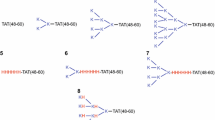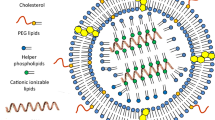Abstract
Purpose. A factor limiting the effectiveness of antisense (AS) deoxyoligonucleotides (ODNs) is inefficient transport to their sites of action in the cytoplasm and in the nucleus. The extent of ODN transfer from endosomes to cytosol seems to be an important determinant of ODN effects. Consequently, the development of compounds (adjuvants) that enhance endosome to cytosol transfer may be vital in AS ODN therapeutics.
Methods. In this report, we evaluated compounds for their potential to enhance the effects of phosphorothioate ODNs. The test system used a CHO cell line expressing the enzyme chloramphenicol acetyl-transferase (CAT) under the control of an inducible promoter. Several potential endosomal disrupting adjuvants were screened, including: (a) fusogenic peptides; (b) a pH sensitive polymer; (c) polymeric dendrimers, (d) cationic liposomes and (e) a pH sensitive surfactant N-dodecyl 2-imidazole-propionate (DIP). ODN effects were evaluated at the protein level by quantitating levels of CAT.
Results. The use of AS ODN in co-incubation with the GALA peptide, cationic liposomes or 5th generation dendrimers resulted in a 35–40% reduction in CAT expression. The mis-matched ODN had no effect on CAT expression. Only modest effects were observed with the other adjuvants. DIP did not increase ODN activity by itself; however, when the liposomal form was used a significant reduction (48%) in CAT activity was seen.
Conclusions. We found the fusogenic peptide GALA, dendrimers, as well as the liposomal form of DIP, could significantly enhance the effects of ODNs.
Similar content being viewed by others
REFERENCES
S. Akhtar, and R. L. Juliano. Cellular uptake and intracellular fate of AS oligonucleotides. Trends in Cell Biol. 2:139–144 (1992).
F. R. Maxfield. Weak bases and ionophores rapidly and reversibly raise the pH of endocytic vesicles in cultured mouse fibroblast. J. Cell. Biol. 95:676–681 (1982).
C. A. Stein, J. L. Tonkinson, L.-M. Zhang, L. Yakubov, J. Gervasoni, R. Taub, and S. A. Rotenberg. Dynamics of the internalization of phosphodiester oligodeoxynucletides in HL60 cells. Biochemistry. 32:4855–4861 (1993).
Y. Shoji, S. Akhtar, A. Periasamy, B. Herman, and R. L. Juliano. Mechanism of cellular uptake of modified oligodeoxynucleotides containing methylphosphonate linkages. Nucleic Acids Research. 19:5543–5550 (1991).
T. L. Fisher, T. Terhorst, X. Cao, and R. W. Wagner. Intracellular disposition and metabolism of fluorescentyl-labeled unmodified oligonucleotides microinjected into mammalian cells. Nucl. Acid Res. 21:3857–3865 (1993).
J. P. Leonetti, N. Mechit, G. Degols, C. Gagnor, and B. Lebleu. Intracellular distribution of microinjected AS oligonucleotides. Proc. Natl. Acad. Sci. 88:2702–2706 (1991).
P. L. Felgner, T. R. Gadek, M. Homn, R. Roman, H. W. Chan, J. P. Wenz, G. M. Ringold, and M. Danielsin. Lipofection: a highly efficient, lipid-mediated DNA-transfection procedure. Proc. Natl. Acad. Sci. 84:7413–7417 (1987).
C. F. Bennett, M.-Y. Chiang, H. Chan, J. E. E. Shoemaker, and C. K. Mirabelli. Cationic lipids enhance cellular uptake and activity of phosphorothioate AS oligonucleotides. Mol. Pharm. 41:1023–1033 (1992).
J.-P. Leonetti, G. Degols, and B. Leble. Biological activity of oligonucleotide-poly(l-lysine) conjugates: mechanism of cell uptake. Bioconjugate Chem. 1:149–153 (1990).
C. Plank, B. Oberhauser, K. Mechtler, C. Koch, and E. Wagner. The influence of endosome-disruptive peptides on gene transfer using synthetic virus-like gene transfer systems. J. Biol. Chem. 269:12918–12924 (1994).
J. Haensler, and F. C. J. Szoka. Polyamidoamine cascade polymers mediate efficient transfection of cell in culture. Bioconjugate Chem. 4:372–379 (1994).
R. A. Parente, S. Nir, and F. C. J. Szoka. Mechanism of leakage of phospholipid vesicle contents induced by the peptide GALA. Biochemistry 29:8720–8728 (1990).
D. A. Tirrell, D. Y. Takigawa, and K. Seki. pH sensitization of phospholipid vesicles via complexation with synthetic poly (carboxylic acid)s. Annal. New York Acad. Sci. 446:237–247 (1985).
J. A. Hughes, C. F. Bennett, P. D. Cook, C. J. Guinosso, C. K. Mirabelli, and R. L. Juliano. The lipid membrane permeability of 2′ modified derivatives of phosphorothioate oligonucleotides. J. Pharm. Sci. 83:597–600 (1994).
R. C. MacDonald, R. I. MacDonald, B. P. M. Menco, K. Takeshita, N. K. Subbarao, and L.-R. Hu. Small-volume extrusion apparatus for preparation of large unilamellar vesicles. Biochim Biophys Acta. 1061:297–303 (1991).
S. S. Makarov, C. Jonat, and S. Haskill. Hyperinducible human metallothionein promoter with low level basal activity. Nucl. Acids Res. 22:1504–1505 (1994).
S. P. C. Cole. Rapid chemosensitivity testing of human lung tumor cells using MTT assay. Cancer Chemother. Pharmacol. 17:259–263 (1986).
B. A. Bunnell, F. K. Askari, and J. M. Wilson. Targeted delivery of AS oligonucleotides by molecular conjugates. Som. Cell and Mol. Gen. 18:559–569 (1992).
K. Wiechelman, R. Braun, and J. Fitzpatrick. Investigation of the bicinchoninic acid protein assay identification of the groups responsible for color formation. Anal. Biochem. 175:231–237 (1988).
A. Martin. “Physical Pharmacy.” 1993 Lea & Febiger. Philadelphia.
S. Buyuktimkin, N. Buyuktimkin, and J. H. Rytting. Synthesis and enhancing effect of dodecyl 2-(N,N-dimethylamino)propionate on the transepidermal delivery of indomethacin, clonidine, and hydrocortisone. Pharm. Res. 10:1632–1637 (1993).
C. Wahlestedt. AS oligonucleotide strategies in neuropharmacology. Trends Pharm. Sci. (1994).
W. R. Jarnagin, R. J. Debs, S.-S. Wang, and D. M. Bissell. Cationic lipid-mediated transfection of liver cells in primary culture. Nucl. Acids. Res. 20:4205–4211 (1992).
J. H. Felgner, R. Kumar, C. N. Sridhar, C. J. Wheeler, Y. J. Tsai, R. Border, P. Ramsey, M. Martin, and P. L. Felgner. Enhanced gene delivery and mechanism studies with a novel series of cationic lipid formulations. J Biol Chem. 269:2550–61 (1994).
X. Zhou, and L. Huang. DNA transfection mediated by cationic liposomes containing lipopolylysine: Characterization and mechanism of action. Biochim. Biophys. Acta. Bio-Membr. 1189:195–203 (1994).
E. Wagner, K. Zatloukal, M. Cotten, H. Kirlappos, K. Mechtler, D. T. Curiel, and M. L. Birnstiel. Coupling of adenovirus to transferrin-polylysine/DNA complexes greatly enhances receptor-mediated gene delivery and expression of transfected genes. Proc. Natl. Acad. Sci. 89:6099–6103 (1992).
M. Cotten, E. Wagner, and M. L. Birnstiel. Receptor-mediated transport of DNA into eukaryotic cells. Met. Enzmol. 217:618–643 (1993).
R. A. Firestone, and J. M. Pisano. Lysosomotropic Agents. 1. Synthesis and cytotoxic action of lysosomotropic detergents. J. Med. Chem. 22:1130–1133 (1979).
P. D. Wilson, R. A. Firestone, and J. Lenard. The role of lysosomal enzymes in killing mammalian cells by the lysosomotropic detergent N-dodecylimidazole. J. Cell. Biol. 104:1123–1229 (1987).
R. B. Gennis. “Biomembranes: Molecular structure and function.” 1989 Springler-Verlag. New York.
Author information
Authors and Affiliations
Rights and permissions
About this article
Cite this article
Hughes, J.A., Aronsohn, A.I., Avrutskaya, A.V. et al. Evaluation of Adjuvants that Enhance the Effectiveness of Antisense Oligodeoxynucleotides. Pharm Res 13, 404–410 (1996). https://doi.org/10.1023/A:1016044609972
Issue Date:
DOI: https://doi.org/10.1023/A:1016044609972




